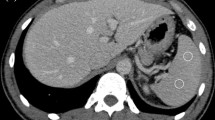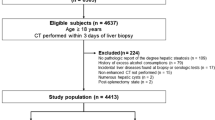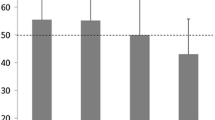Abstract
Purpose: The study purpose was to prospectively determine the accuracy of contrast-enhanced CT in diagnosing fatty liver using same-day biopsy as the reference standard. Materials and methods: One hundred seventy-nine potential living liver donors underwent unenhanced and portal-phase contrast-enhanced hepatic CT and subsequent liver biopsy on the same day. Attenuation difference between the liver and the spleen on unenhanced ( pre L-S) and contrast-enhanced ( post L-S) images and blood-subtracted hepatic attenuation on contrast-enhanced images ( post L-B), calculated by [L - 0.3 × (0.75 × P + 0.25 × A)]/0.7 where L, P and A represent the attenuation of the liver, main portal vein and abdominal aorta, respectively, were obtained. The accuracy of these indices in diagnosing fatty liver according to various threshold levels, 5%-30% histological steatosis in increments of 5%, was compared using ROC analysis. Results: The area under the ROC curve for pre L-S, post L-S and post L-B was 0.663–0.918, 0.712–0.847 and 0.821–0.923, respectively, depending on the threshold levels of hepatic steatosis. The accuracy of pre L-S and post L-S did not differ (P ≥ 0.054), despite a trend towards a lower accuracy with post L-S. post L-B yielded higher accuracy than pre L-S at threshold levels of 5% and 10% (P ≤ 0.002) and similar accuracy to pre L-S at the other threshold levels (P ≥ 0.144). Conclusion: Portal-phase contrast-enhanced CT has a similar, or even greater, accuracy than unenhanced CT in diagnosing fatty liver.




Similar content being viewed by others
References
Kooby DA, Fong Y, Suriawinata A et al (2003) Impact of steatosis on perioperative outcome following hepatic resection. J Gastrointest Surg 7:1034–1044
Nocito A, El-Badry AM, Clavien PA (2006) When is steatosis too much for transplantation? J Hepatol 45:494–499
Adams LA, Lymp JF, St Sauver J et al (2005) The natural history of nonalcoholic fatty liver disease: a population-based cohort study. Gastroenterology 129:113–121
de Alwis NM, Day CP (2008) Non-alcoholic fatty liver disease: the mist gradually clears. J Hepatol 48(Suppl 1):S104–112
Ekstedt M, Franzen LE, Mathiesen UL et al (2006) Long-term follow-up of patients with NAFLD and elevated liver enzymes. Hepatology 44:865–873
Farrell GC, Larter CZ (2006) Nonalcoholic fatty liver disease: from steatosis to cirrhosis. Hepatology 43:S99–S112
Rector RS, Thyfault JP, Wei Y, Ibdah JA (2008) Non-alcoholic fatty liver disease and the metabolic syndrome: an update. World J Gastroenterol 14:185–192
Watanabe S, Yaginuma R, Ikejima K, Miyazaki A (2008) Liver diseases and metabolic syndrome. J Gastroenterol 43:509–518
Johnston RJ, Stamm ER, Lewin JM, Hendrick RE, Archer PG (1998) Diagnosis of fatty infiltration of the liver on contrast enhanced CT: limitations of liver-minus-spleen attenuation difference measurements. Abdom Imaging 23:409–415
Kodama Y, Ng CS, Wu TT et al (2007) Comparison of CT methods for determining the fat content of the liver. AJR Am J Roentgenol 188:1307–1312
Lall CG, Aisen AM, Bansal N, Sandrasegaran K (2008) Nonalcoholic fatty liver disease. AJR Am J Roentgenol 190:993–1002
Lee SW, Park SH, Kim KW et al (2007) Unenhanced CT for assessment of macrovesicular hepatic steatosis in living liver donors: comparison of visual grading with liver attenuation index. Radiology 244:479–485
Limanond P, Raman SS, Lassman C et al (2004) Macrovesicular hepatic steatosis in living related liver donors: correlation between CT and histologic findings. Radiology 230:276–280
Panicek DM, Giess CS, Schwartz LH (1997) Qualitative assessment of liver for fatty infiltration on contrast-enhanced CT: is muscle a better standard of reference than spleen? J Comput Assist Tomogr 21:699–705
Park SH, Kim PN, Kim KW et al (2006) Macrovesicular hepatic steatosis in living liver donors: use of CT for quantitative and qualitative assessment. Radiology 239:105–112
Ricci C, Longo R, Gioulis E et al (1997) Noninvasive in vivo quantitative assessment of fat content in human liver. J Hepatol 27:108–113
Jacobs JE, Birnbaum BA, Shapiro MA et al (1998) Diagnostic criteria for fatty infiltration of the liver on contrast-enhanced helical CT. AJR Am J Roentgenol 171:659–664
Ganong WF (1999) Circulation through special regions. In: Ganong WF (ed) Review of medical physiology. 9th edn. Appleton & Lange, Stamford, Conn, p 596
D’Angelica M, Fong Y (2004) The liver. In: Townsend CM, Beauchamp RD, Evers BM, Mattox KL (eds) Textbook of surgery,. 17th edn. Elsevier Saunders, Philadelphia, Pa, p 1528
LeSage GD, Baldus WP, Fairbanks VF et al (1983) Hemochromatosis: genetic or alcohol-induced? Gastroenterology 84:1471–1477
Wai CT, Tan LH, Kaur M, Da Costa M, Quak SH, Tan KC (2002) Pitfalls in interpreting liver biopsy results: the story of the blind men and the elephant. Liver Transpl 8:1200–1201
Bewick V, Cheek L, Ball J (2004) Statistics review 13: receiver operating characteristic curves. Crit Care 8:508–512
Bland JM, Altman DG (1986) Statistical methods for assessing agreement between two methods of clinical measurement. Lancet 1:307–310
Alpern MB, Lawson TL, Foley WD et al (1986) Focal hepatic masses and fatty infiltration detected by enhanced dynamic CT. Radiology 158:45–49
Lee JY, Kim KM, Lee SG et al (2007) Prevalence and risk factors of non-alcoholic fatty liver disease in potential living liver donors in Korea: a review of 589 consecutive liver biopsies in a single center. J Hepatol 47:239–244
Balci A, Karazincir S, Sumbas H, Oter Y, Egilmez E, Inandi T (2008) Effects of diffuse fatty infiltration of the liver on portal vein flow hemodynamics. J Clin Ultrasound 36:134–140
Ijaz S, Yang W, Winslet MC, Seifalian AM (2003) Impairment of hepatic microcirculation in fatty liver. Microcirculation 10:447–456
Mihmanli I, Kantarci F, Yilmaz MH et al (2005) Effect of diffuse fatty infiltration of the liver on hepatic artery resistance index. J Clin Ultrasound 33:95–99
Seifalian AM, Piasecki C, Agarwal A, Davidson BR (1999) The effect of graded steatosis on flow in the hepatic parenchymal microcirculation. Transplantation 68:780–784
Bae KT (2006) Principles of contrast medium delivery and scan timing in MDCT. In: Saini S, Rubin GD, Kalra MK (eds) MDCT: a practical approach. 1st edn. Springer-Verlag Italia, Milan, pp 10–24
Author information
Authors and Affiliations
Corresponding author
Additional information
Financial support:
This study was supported by a grant (07–428) from the Asan Institute for Life Sciences, Seoul, Korea
Rights and permissions
About this article
Cite this article
Kim, D.Y., Park, S.H., Lee, S.S. et al. Contrast-enhanced computed tomography for the diagnosis of fatty liver: prospective study with same-day biopsy used as the reference standard. Eur Radiol 20, 359–366 (2010). https://doi.org/10.1007/s00330-009-1560-x
Received:
Revised:
Accepted:
Published:
Issue Date:
DOI: https://doi.org/10.1007/s00330-009-1560-x




